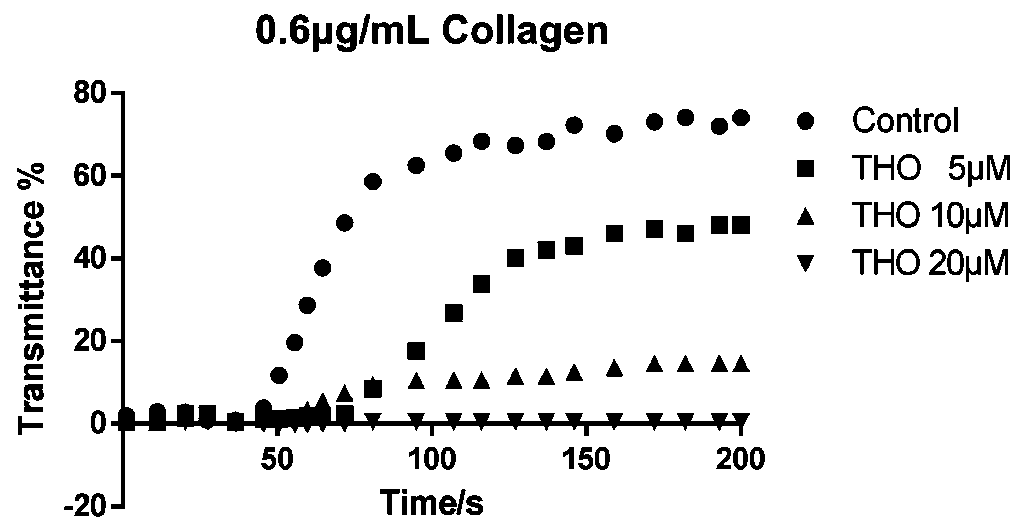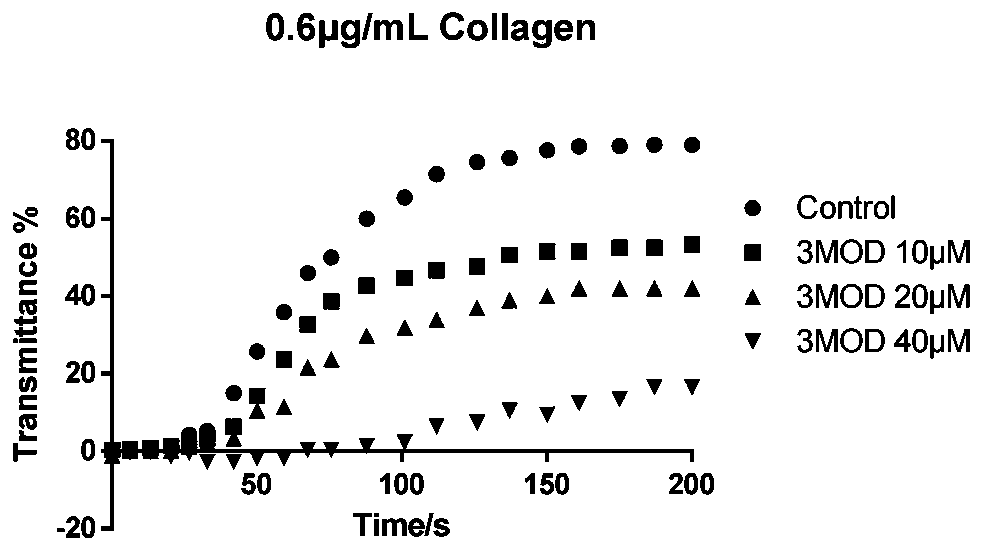Application of 3,4,7-trihydroxyisoflavone or 3-methoxydaidin in the preparation of drugs for inhibiting platelet aggregation and thrombus
A technology of trihydroxyisoflavone and platelet aggregation, applied in the field of biomedicine, can solve the problems of increased bleeding risk, weakened drug efficacy, and impact on the life and health of patients in clinical use.
- Summary
- Abstract
- Description
- Claims
- Application Information
AI Technical Summary
Problems solved by technology
Method used
Image
Examples
preparation example Construction
[0041]The present invention also provides the preparation method of the oral preparation, which comprises the following components in mass percent: 5-20% active ingredient, 2-10% disintegrant, 0.2-2% lubricant, 0.1-1.5% % of glidant, 0-0.5% of additives, and the balance of fillers are mixed to make an oral agent; the active ingredient is 3,4,7-trihydroxy isoflavone or 3-methoxydaidin.
[0042] In the present invention, the administration frequency of the oral agent is once a day, and 3-7 days is a course of treatment.
Embodiment 1
[0045] Platelets from healthy people were diluted with plasma to 2.5×10 8 individual / mL. Take 300 μL of plasma-rich platelets, add different concentrations of samples and incubate at 37°C for 5 minutes, then add 70 μmol / L ADP to induce aggregation, and draw the aggregation curve within 5 minutes on a platelet aggregometer. Platelet aggregation without sample treatment was used as a control.
[0046] Detection of collagen-induced platelet aggregation using washed human platelets. Such as figure 1 As shown, 3,4,7-trihydroxyisoflavone and its analogs inhibit platelet aggregation induced by 0.6 μg / mL collagen in a gradient-dependent manner. 20μM 3-methoxydaidin can inhibit about 50% of platelet aggregation, while 20μM 3,4,7-trihydroxyisoflavone can completely inhibit platelet aggregation. The platelet washing method is as follows:
[0047] a. Each 1.5mLEP tube was filled with 1.4mL platelets (platelet-concentrated plasma), centrifuged at 400g for 5min at room temperature, and...
Embodiment 2
[0054] Rat tail thrombosis model induced by carrageenan
[0055] Male Kunming mice, weighing 20-25 g, were used as experimental animals. After feeding for one week, they were randomly divided into groups (n=10). The first group is the normal saline control group, the sample group is administered with 3,4,7-trihydroxy isoflavone and 3-methoxydaidin at concentrations of 33, 100, and 300 μmol / kg, respectively, and the positive control is administered with 300 μmol / kg clopidogrel Gray gavages. After intragastric administration for 30 minutes, the mice were intraperitoneally injected with carrageenan (carrageenan, type I, Sigma) at a dose of 40 mg / kg. Since the thrombus formation rate was >90% in a low temperature environment, the feeding temperature used was 18°C. After 24 hours, the average length of thrombus was determined according to the change of tail skin color. Oral administration of 3,4,7-trihydroxyisoflavone and 3-methoxydaidin has a greater inhibitory rate on thrombus ...
PUM
 Login to View More
Login to View More Abstract
Description
Claims
Application Information
 Login to View More
Login to View More - R&D
- Intellectual Property
- Life Sciences
- Materials
- Tech Scout
- Unparalleled Data Quality
- Higher Quality Content
- 60% Fewer Hallucinations
Browse by: Latest US Patents, China's latest patents, Technical Efficacy Thesaurus, Application Domain, Technology Topic, Popular Technical Reports.
© 2025 PatSnap. All rights reserved.Legal|Privacy policy|Modern Slavery Act Transparency Statement|Sitemap|About US| Contact US: help@patsnap.com



